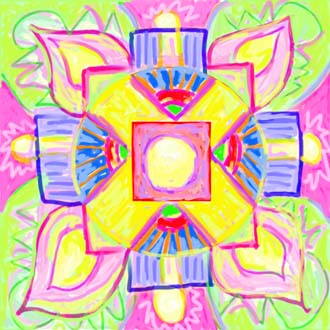September 22, 2007

Each of these mandalas pictures the universal in a singular expression, and thus mirrors our own individual window on eternity. For seven years, between November 13, 2004 and November 13, 2011, I offered daily my individual perspective on this Great Mystery. You may download from these archives and use the mandalas, provided this blog's URL is credited. To purchase a CD copy of the collection, hi-res prints, license information, see henryreed.com
2 Comments:
Lovely, lovely, lovely…..
http://www.harekrsna.de/Lotus-FLower.htm
Throughout many cultures over time, the lotus has been a powerful image and a spiritual symbol. In Hindu, Buddhist and Egyptian religions, the lotus is considered a sacred flower.
Among its many meanings and significance, the lotus is a symbol of "spontaneous" generation, and so it also represents divine birth, spiritual development and creation itself.
The bud of the lotus symbolizes potential, specifically of a spiritual nature.
Because the lotus rises from unclean water to blossom as a pure, uncontaminated flower, it is a symbol of purity and resurrection.
In the same way the lotus flower goes through much in its growth before emerging from dirty water to become a beautiful flower, the individual consciousness does the same on its path to enlightenment as the so-called impurities of unenlightened thinking gradually fade.
The Mahayana sect of Buddhism maintains that all souls emerge from a lotus.
According to ancient scriptural text which details the life of Gautama Buddha, "the spirit of the best of men is spotless, like the new lotus in the [murky] water which does not adhere to it." As the lotus is pure in the water, so the soul is also pure.
The lotus is one of the eight auspicious signs of Buddhism and Hinduism, and the eight-petaled lotus seen in Buddhist mandalas means cosmic harmony. (Mandalas are geometric patterns used as symbolic or metaphysical representations of the universe, the spiritual path, etc.; mandalas are often used as a object of focus to aid in meditation.)
The eight petals of the white lotus correspond to the Noble Eightfold Path of the Good Law. This lotus is found at the heart of the Garbhadhatu Mandala, regarded as the womb or embryo of the world.
The thousand-petaled lotus signifies spiritual illumination. In this case, each opening of the petal is the gradual unfolding of the consciousness on the path of enlightenment.
The specific yogic teaching that addresses energy centers within the human being, known as the chakra system, uses a lotus with varied numbers of petals to represent each particular chakra. The crown chakra is the thousand-petaled lotus, and so its blossoming indicates enlightenment.
The Buddhist mantra "Om mani padme hum" refers to the "jewel in the lotus," which represents enlightenment. It is claimed that this mantra has great mystical power, with transcendental truth in its words.
In buddhist and hindu writings, it is explained that "Om mani padme hum" [O Jewel in the Lotus Flower] "signifies not only the jewel of man's divinity living within the lotus (the cosmos), but also the jewel of cosmic divinity living within the lotus (man). In other words, the mantra is saying, "I am in You and You are in me," thereby stating the unity and brotherhood of all beings, as well as their inner divine potential. This is one way of expressing the principle of "As above, so below."
Henry,
I am inspired by your 'sacred art'. This one invited beauty, joy, and deep inner love.
Post a Comment
<< Home